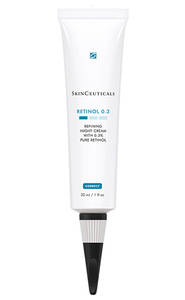Retinol is recognised as the gold standard in anti-ageing ingredients. It is the most researched ingredient. Thanks to the myriad anti-ageing benefits of retinol, there are loads of products containing the powerful ingredient on the market, including serums, creams, eye masks and even drops. The kind of retinol you use comes down to your skin type and personal preference, but regardless of the format, moisturising is essential to offset its potential drying effects.
Retinoids have always had a great reputation when it comes to anti-ageing. Retinol increases cell turnover, meaning that it sheds off dead skin cells to stimulate new skin growth. Stimulating new skin growth helps achieve fewer wrinkles and brighter, more even skin tones.
How Retinol Works
Retinol, a type of retinoid, is derived from vitamin A. It permeates your epidermis—the skin’s outer layer—to reach your dermis. Once it’s in that middle layer, retinol works to neutralise free radicals, which boosts the production of collagen and elastin. That, in turn, creates a plumping effect that can help reduce the appearance of wrinkles, fine lines, crow’s feet, enlarged pores, and other signs of ageing. It also has an exfoliating effect on the skin’s surface that can help improve tone and texture.
Including Retinol in Your Winter Regimen
No one nighttime skincare routine is the same for every face, but there are some consistent, foundational steps (including how best to use retinol):
- Cleanse. In the winter, use a gentle, sulphate, alcohol, and phthalate-free cleanser with warm water.
- Serums. Cell Cycle Catalyst - apply all over face and neck. Apply your vitamin C antioxidant on clean, dry skin - leave for a minute . Apply 4 drops of PTiox. Hyaluronic seums are like a drink of water for your skin. As these are light, easily absorbed by the skin, and a hydrating serum, one with hyaluronic acid, like HA Intensifier Multi-Glycan for example, can help moisture reach your skin’s deeper layers. Each serum have different ingredients which has a complimentary function.
- Moisturise. The thicker formulas found in moisturisers help create a physical barrier that locks in hydration, prevents skin from drying out, and bolsters your skin’s outer moisture barrier.
- We recommend that SkinCeuticals Triple Lipid Moisturiser be paired with a retinol. It contains three essential lipids—ceramides, cholesterol, and fatty acids—that help restore the skin barrier that retinols disrupt. Meaning, it helps with the peeling /shedding side effects from the retinol, making skin more tolerant.
- Skinceuticals Advanced AGE Interrupter alongside your retinoid is another great way to help speed up recovery time. Less is more! You only need around a pea sized amount to be effective.
- SPF. You may feel that you are not seeing much sunshine particulary as we head in to winter , but the sun’s UV rays aren’t any weaker. You still need protection.
Listen to your skin, if you feel like the negative is outweighing the positive skip a couple more days to give your skin a chance to recover. This is particularly relevant in the case of retinol.
Note it is important to address skin sensitivities before introducing retinol. Start on a low % and slow – start once or twice a week – no harm to patch test if you are worried about sensitivities.
Retinols should be used at night. You could go up earlier to clean your skin – apply the retinol on dry skin – apply a moisturiser later when going to bed. However, if you’re experiencing dryness from cell turnover, you might want to mix your retinol with the moisturiser, which makes the retinol less potent. Do this until your skin becomes, more resilient. We love SkinCeuticals Retinol 0.3.
Retinols can be used on all skin types: dry, oily, and combination skin. It’s especially helpful for discolouration, acne, and ageing skin. If your cell turnover is high and you’re experiencing dryness, use retinol every other night and slowly increase to nightly to allow your skin to build up a tolerance.
Sensitivity: Some people may have inherent sensitivity to retinoids, and their skin may not tolerate them well. If you have very sensitive skin or a history of adverse reactions to retinoids, it's important to use caution and consider lower concentrations or alternative treatment options.
The benefits of using a retinoid can take a few weeks to start to show, as with any new skincare routine. Give it a chance and we are confident you will start to see the benefits of reduced fine lines, improved texture and reduced pigmentation.
Some people say that retinol can thin your skin – the truth is the opposite . As we age the surface of the skin thickens which can result in more uneven texture, open pores etc and the dermis thins – retinol refines the epidermis – the surface and it thickens the dermis, so in fact it corrects some aspects of ageing. Retinol also has the ability to correct the damaged messages sent to the DNA in our cells.
What are retinoids?
They come from vitamin A and are used in skincare worldwide. They can be natural and sourced from animals such as fish liver. However, they can be synthetic, which is favoured in skincare for their stability.
What are retinoids known benefits?
- Increased cell turnover
- Increased collagen production
- Clear pores
- Clear skin
- Improved fine lines
- Improved skin tone
- Reduced wrinkles
- Reduced pigmentation
How do they work?
Retinoids work by binding to specific receptors in the skin cells, triggering a series of responses within the cell, from regulating gene expression regulation, to simulating collagen synthesis, and accelerating cell turnover.
What is the difference between retinoids in skincare?
The most talked about retinoids in skincare are retinol, retinal and tretinoin.
How to figure out the benefits of each and which would work best for you:
In summary, retinol is lower potency, leading up to tretinoin which is prescription only and the strongest of the three options.
Each come with common side effects, which can be more manageable by:
Using it just a couple of times a week in your routine to build up a tolerance at a lower percentage, and gradually building up to a stronger percentage more frequently. Note we do not believe that you need a strong strenght to see results.
A decent moisturiser is also advised to help with the skin’s recovery time and for particularly sensitive skin, the sandwich technique can be favoured. This is a technique of layering the moisturiser and retinoid on your skin to create a slight barrier.
Using products such as the Skinceutical Triple lipid restore 2:4:2 or Advanced AGE interrupter alongside your retinoid is a great way to help speed up recovery time.
With retinol - less is more! You only need around a pea sized amount to be effective.
Common side effects:
- Dryness and Peeling: Retinoids can cause dryness, flakiness, and peeling of the skin. This occurs because they increase the turnover of skin cells, which can lead to the shedding of the outermost layer of skin. Using a moisturiser can help alleviate dryness and reduce peeling.
- Irritation and Redness: Some individuals may experience skin irritation, redness, and sensitivity when first using retinoids. This can manifest as a stinging or burning sensation on the skin. Starting with a lower concentration of retinoid or applying it less frequently can help minimise irritation. It's important to allow your skin to gradually adjust to the retinoid.
- Sensitivity to Sunlight: Retinoids can make your skin more sensitive . It is crucial to use sunscreen with a high SPF (sun protection factor) during the day and limit sun exposure. This helps prevent sunburn and reduces the risk of sun damage.
- “Purging”: For individuals using retinoids to treat acne, it is not uncommon to experience a temporary worsening of acne before improvement occurs. This is known as the "purging" phase, where existing clogged pores may come to the surface and cause breakouts. This phase typically resolves with continued use, leading to clearer skin in the long run.
- Sensitivity: Some people may have inherent sensitivity to retinoids, and their skin may not tolerate them well. If you have very sensitive skin or a history of adverse reactions to retinoids, it's important to use caution and consider lower concentrations or alternative treatment options.
The benefits of using a retinoid can take a few weeks to start to show, as with any new skincare routine.
Give it a chance and we are confident you will start to see the benefits of reduced fine lines, improved texture and reduced pigmentation.
To really combat irritation and flaking, you might also want to try something called a “retinol sandwich”.
What Is a Retinol Sandwich?
A retinol sandwich simply entails layering retinol between two applications of a non-active moisturiser.
To do it, apply moisturiser to cleansed skin. Next, use your retinol product as directed on the package, remember a small amount goes a long way, avoiding sensitive areas like the eyelids and corners of the mouth. Then complete your “sandwich” by adding another generous layer of moisturiser on top. This second layer of moisturiser can either be the same formula you used for the first or a thicker one, depending on how much hydration you need.
Who Should Use a Retinol Sandwich?
People with any skin type can try this regimen, but it’s especially helpful for those with sensitive or dry skin. It could also be helpful for oily skin in the winter to prevent irritation, and even combination skin can benefit because areas that are drier can prevent breakouts.
How to Create the Perfect Retinol Sandwich
After cleansing the skin in the evening, we recommend applying a lightweight moisturiser with ceramides, like the Triple Lipid by SkinCeuticals. And whenever you use a retinol, make sure to apply, and reapply, a broad-spectrum sunscreen during the day because the ingredient can make skin more sensitive to UV damage.























































